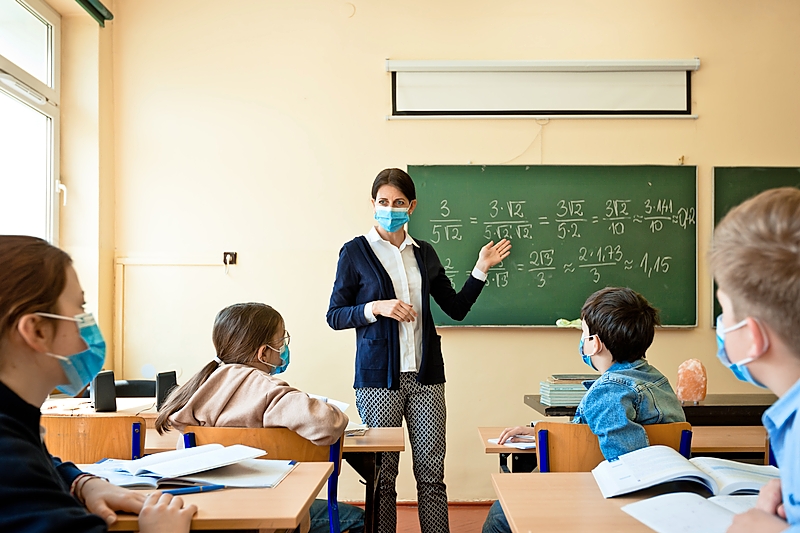“A” for Effort
By Naperville Magazine
August 2020 View more 630

By Christie Willhite
If everything goes well, area students could attend in-person classes this month for the first time since March, when schools closed to help minimize transmission of the coronavirus. But though the teachers and the classrooms will be familiar, school will be far from “normal,” as children, parents, and educators adapt to the state-issued guidelines meant to keep students, school employees, and families healthy.
“It’s going to be a balancing act. I think of a typical day one of school—kids coming in and hugging teachers they haven’t seen, I could have a kindergarten student I would walk hand in hand to their classroom,” says Adrian Talley, who took the helm of Indian Prairie Unit District 204 as superintendent on July 1. “All of that will have to change. And yet, we also want to make it is as welcoming as possible.”
In the new version of school, face coverings and social distancing will be required for students and staff members, along with symptom checks, group limits of 50 people, and increased cleaning efforts. Officials in D204 and their counterparts in Naperville Community Unit School District 203 have been planning how to reopen schools since closing their doors in March: tracking the state’s progress, monitoring safety recommendations, learning from a spring of remote instruction, and imagining how to bring it all together in a way that best serves children, D203 superintendent Dan Bridges says.
“Our thinking has been: How do we get our kids back in school for face-to-face instruction? We know that is what is best for their physical, emotional, and social well-being,” Bridges says. “With one of the guiding principles being we prefer face to face—because it’s best for the health of our kids—we said, ‘If this is what we want to happen, what are the steps we have to take to get there?’ ”
Administrators in both districts outlined reopening plans for their school boards in mid-July that reimagine traditional attendance as a blend of in-person and remote education. By splitting the enrollment so that students alternate between being in class and learning remotely, administrators lower the number of students in a classroom at one time and create space for distancing.
“The challenge for us will be to have differences among the levels,” says Bridges, noting that the strength of a unit district traditionally comes from providing continuity from kindergarten through high school. “Remote learning worked much better for high school students than for our youngest learners.”
Both parents and teachers urged the district to incorporate real-time instruction for students learning from home, especially to help elementary grade students and teachers connect, he says.
“One thing we know as we pay attention to social/emotional learning, is it is difficult to develop online,” Bridges says. “We know we have to think differently.”
Talley agrees, saying District 204 likely will offer additional training to help teachers—and in particular, those new to the career—build a classroom community when the class isn’t together every day.
“One insight I think parents will appreciate is that as educators, we always want to see our children,” he says. “It’s most important that we have a program where children are being challenged, where children are learning, and where we address the social/emotional learning.”
Administrators and staff still are addressing myriad issues as they figure out how to apply the Illinois Department of Public Health’s phase 4 reopening recommendations in a school setting.
How and where is it safe for children to eat lunch? Can they play on the playground and maintain distance? How do you keep kids separated in the halls, at their lockers, and in locker rooms?
“How we do lunch, bathroom breaks—all of those things will have protocols in place,” Talley says. “Everyone will have to understand, it just won’t be the same as it was at the beginning of last year.”
Talley, who began planning with D204 leaders weeks before his official start date, says the team has been looking for options that minimize movement and the likelihood of virus transmission. At the elementary level, for example, children might stay in their classrooms as the adults come to them to teach art, music, or differentiated instruction. Or in high schools, hallways and stairwells could become one-way to better allow for spacing, he says.
“High-transmission activities are when people are not wearing masks. To me, the only activity that is really required during the school day where a mask is not worn is eating and drinking,” says Dr. Jennifer McNulty, director of the emergency pediatric department and medical director of pediatrics at Edward Hospital in Naperville.
“I would suggest that waiting several months to start indoor gym, choir, or music may be necessary.”
These activities all involve deep breathing and forceful exhalation—activities directly linked to the spread of coronavirus, McNulty says. Such classes may need to meet outdoors and with increased distancing if they’re to occur.
With all the changes, the key to success will be ensuring students have the guidance, support, and understanding they need to navigate this new normal.
“We have to work with the children and be human about it all,” Talley says. “The (health) guidance is one thing and we will follow it, but we have to be human about it.”
Photo courtesy Indian Prairie School District 204 (Talley)


